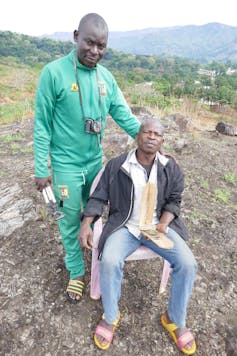Tomás Saraceno In Collaboration: Web(s) of Life, which opened at London’s Serpentine South Gallery in June, explores how humans relate to spiders. It features installations of spider webs displayed and lit to be viewed as sculptures. There are also films: one made about Saraceno’s work with groups battling lithium mining in Argentina and another about spider diviners from Somié village in Cameroon.
That’s where I came in. Ŋgam dù (the Mambila term for spider divination) is one of many types of oracle or divination used by Mambila people in Cameroon. It is the most trusted form and – unlike other types which are sometimes dismissed as mere games – its results can be used as evidence in the country’s courts. Variants of this form of divination are found throughout southern Cameroon and the long history of the word ŋgam attests to the longevity of the practice.
I work as a social anthropologist in the Mambila village of Somié. I have visited almost every year since 1985, working on a variety of projects. Divination was the focus of a chapter in my PhD in 1990, but I never stopped working on the subject. As well as becoming an initiated diviner, I have continued to think about the wider implications of using divination or oracles.
Ngam dù is a form of divination in which binary (either/or) questions are asked of large spiders that live in holes in the ground. The options are linked to a stick and a stone then, using a set of leaf cards marked with symbols, the spider is left to make its choice.
The hole plus the stick, stone and cards are covered up. The spider emerges and will move the cards so the diviner can then interpret the pattern relative to the stick and stone. If cards are placed on the stick, then the option associated with that has been selected, and vice versa if the cards are placed on the stone.
Things get more interesting (at least to me and other diviners) if both options are selected, or neither. Sometimes a contradictory response is interpreted to mean that the question posed is not a good one. The diviner is thereby told to go and discuss the issue with the client and reframe the problem, posing a different question.

The process is “calibrated” regularly by asking test questions such as “Am I here alone?” or “Will I drink tonight?”. Spiders that fail these tests are discarded as liars and not used for future consultations. It’s also common to ask the same question in parallel to get a consistency check, so more than one spider can be used at the same time. Sometimes the stick and stone option are reversed to ensure that the spider isn’t just moving the cards always in the same direction.
Mambila diviners rely on these tests to justify the system, although they also say (as do many groups in Cameroon) that spiders are a source of wisdom since they live in the ground where the “village of the dead” is found.
Tomás Saraceno and spider divination

As an anthropologist, I avoid questions about whether spider divination is true. For me the important question is: “Does it help?”
Sometimes the results of divination are considered, but rejected, and the advice is not followed. Even in these instances it can be helpful, however, since it enables people decide on a course of action.
People use the results as a tool to help them think through hard decisions such as who to marry, or where to go for treatment when a child is ill. The latter involves weighing up conflicting considerations about expense, the possibility an illness has been caused by witchcraft and the reputations for effective treatment of different traditional healers as well as of rival biomedical health centres.
I met the Argentine artist Tomás Saraceno when he had an exhibit at the Venice Bienale in 2018. He was intrigued by the computer simulation of spider divination that my colleague Mike Fischer had made. He invited me to Venice to demonstrate the simulation and talk about spider divination in front of his “sculptures”, which are made in collaboration with spiders. They are patterns of spiderwebs displayed as art.
As we talked, I said that if one day he wanted to visit Cameroon I would be happy to introduce him to the diviners I worked with. In December 2019, he came with his friend, the filmmaker Maxi Laina. We visited Somié, where he worked with the diviner Bollo Pierre Tadios and the Mambila filmmaker Nguea Iréné.
Saraceno and Laina came with some questions to ask from their friends. This included “Who would win the 2020 US election?” This was the Trump v Biden election, the results of which Trump went on to question. The answer was that there would be a new president but it would not be straightforward!
Saraceno liked the idea that spiders could help humans resolve their personal problems. It gave an example of a different way in which human-spider relationships are expressed. Bollo liked the idea of opening the process up to questions from outside the village. He already has some clients from other places in Cameroon who call him, so working internationally is very doable.
He suggested that Saraceno could make his work accessible via the internet, which he has now done through a dedicated website. Some of the first results are included in the Serpentine exhibition along with film made by Nguea Iréné of Bollo in action. The film will also be shown in the village later in the summer.
Tomás Saraceno In Collaboration: Web(s) of Life is on at London’s Serpentine South Gallery until 10 September.

